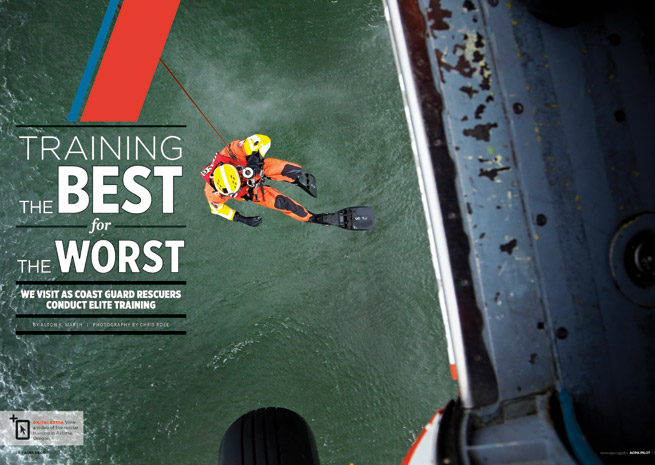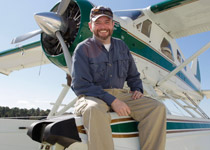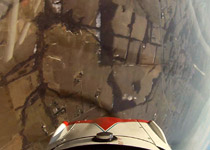Letters: Training the Best for the Worst
Alton K. Marsh’s story on Coast Guard helicopter rescue training on the Oregon coast brought out the patriotism of our members.

As a former United States Coast Guard aviator (1971-1975), it touched me personally to read and re-live (if only in print) the article Al Marsh wrote about the branch of military service that is oft forgotten, but has always been there (since 1917)—the USCG Aviation Branch (“Training the Best for the Worst”). Marsh captured my memories—and the true essence of Coast Guard aviation—of being stationed with some of the most giving, unselfish, can-do, and distinguished, yet usually unheralded men in the world. We were always told, “You have to go out, but you don’t have to come back,” and in the days of being young and dumb and full of piss and vinegar, we did!
You honored those of us who flew, who are now flying—and, most honorably, those of my brothers who died doing what they loved “so that others may live.” Nothing in my life of 60-plus years was more satisfying than seeing that reassured, thankful look in a person’s eyes when the huge white, orange, and blue helicopter with “USCG” on it swooped out of the sky and rescued them from what usually would have been certain injury or death.
I’m glad you got to see a tiny slice of what life on the edge is really like for the brave, bold, and courageous men and women now a generation away from my time doing the same thing—only better!
Greg Dufresne
AOPA 1326561
Bakersfield, California
Thanks for a great article on the USCG advanced swimmer school. I am good friends with Senior Chief Biehn and served with him in the Guard from 1997 to 2001. He is an amazing rescue swimmer; a great friend, father, and husband; and a great asset to the U.S. Coast Guard. I am sure the short time you spent with those guys, you learned a lot about what type of person it takes to do that job.
Phil Hartman
AOPA 3962940
Greencastle, Pennsylvania
It is no wonder Survival Technician Biehn had a difficult time performing a rescue on the Yaquina River Jetty when he was in North Bend, Oregon. The Yaquina River flows into the Pacific Ocean at Newport, Oregon, approximately 90 miles north of North Bend.
Paul Redhead
AOPA 7392808
Eugene, Oregon
Whoops, thanks Mr. Redhead.We missed that.—Ed.
Rationalizing retracts
In Dave Hirschman’s “Rationalizing Retracts,” he says one owner said the only compelling reason to own a retract is “it looks better than a fixed gear.” I must be getting old; you see, when I was a young pilot one tried to constantly advance flight skills and experience. You started flying low-powered fixed gear and worked toward a jet.
So I think the most compelling reason to fly a retract is to gain experience to meet FAA regulations and be insurable as you move up the ladder to more complex aircraft. Indeed, one of the main reasons the twin market is so weak is because those who could afford to move up do not have enough retract experience to be insurable. Another unstated advantage of retracts is they are much safer in an off-field landing, especially over water or soft ground, where fixed-gear craft almost always flip.
Paul Walter
AOPA 856831
Milwaukee, Wisconsin
Having owned my 1977 Cardinal RG for 27 fun-loving years, I felt compelled to paint a more positive picture of retracts, and the Cardinal RG in particular. As I love to fly, I throttle back to about 55 percent power, best economy. Solid as a rock, less noise, less vibration, engine appreciates it, and I burn about 7.5 gallons per hour to boot (as per the manual). Maintenance can occasionally be more costly with the gear, but often a gear swing is the only additional labor expense. Insurance this year will cost me exactly $889. Bottom line: retracts forever!
John Tillison
AOPA 573954
Sacramento, California
Going pilotless
When I read “Proficient Pilot: Going Pilotless,” I thought I was going to have a heart attack. At some point, the phasing out of the crew such as the radio operator and the navigator made some sense, since the technology evolved. To have a complete cockpit free of pilot and co-pilot is a fantasy greed of the airlines. What would have happened if Captain Sully and his co-pilot were not there over the Hudson River? “Will pilotless airplanes appear in the GA aviation fleet? Count on it,” says Barry Schiff. I’m 61 years old and I hope, if this really happens, I’ll be dead by then—probably of a heart attack.
Richard Magnan
AOPA 5493107
Linden, New Jersey
I was entering the aviation workforce as an A&P in the late 1970s with the aspiration of working my way to the left seat from the flight engineer position, which, as Barry Schiff pointed out, was eliminated about that time. Here’s the joke that was told: In the future, aircraft will be operated by a crew of two, a man and a dog. The man’s job will be to feed the dog. The dog’s job will be to bite the man if he attempts to touch the controls.
William Crowl
AOPA 1789433
Wilton, Connecticut
It was most entertaining to read Barry Schiff’s piece on pilotless aircraft. While I fully agree with his conclusions and, understanding that his treatise was mostly tongue-in-cheek, the issue appears to be more economic than technological. As a longtime airline and GA pilot, I’ve been asked more times than I can recall if “we” will ever have the technology to eliminate the pilot from the cockpit. My answer has always been that the technology has existed for many years, so the question is not when it can be done, but when can it be sold? “Would you put your family on such an airplane?” The answer has always been “no.” The instant that time arrives, however, you can bet your bottom dollar (pun intended) that the “break glass in case of emergency” cockpit will be installed in some future air vehicle.
David Moffet
AOPA 1261220
Williamson, Georgia
Spin videos
Really nice job on demonstrating spin recovery (“The Spin Zone”). The camera shots of the panel and elevator/rudder were especially helpful. While I have not experienced a spin, I think I better understand the situation.
Terry Voorhees
AOPA 4830597
Bonita Springs, Florida
Hangar Talk
 An AOPA Pilot survey of favorite magazine covers a few years ago revealed a clear preference among AOPA members for retro, radial-engine aircraft—and de Havilland’s DHC-2 Beaver was at the top of the list. AOPA Photographer Chris Rose went hunting for a float-equipped Beaver that typified the proud and rugged icon of the north, and he found it in Florida, of all places. “Ryan Seaplanes has an absolutely pristine DHC-2 they use for advanced training, and it turned out to be exactly what Chris had been looking for,” said Senior Editor Dave Hirschman (“Beaver Checkout,” page 50). One flight in the muscular, exquisitely balanced Beaver proved that AOPA members have a discerning taste in airplanes. “Our members sure got this one right,” Hirschman said. “This is a de Havilland masterpiece.”
An AOPA Pilot survey of favorite magazine covers a few years ago revealed a clear preference among AOPA members for retro, radial-engine aircraft—and de Havilland’s DHC-2 Beaver was at the top of the list. AOPA Photographer Chris Rose went hunting for a float-equipped Beaver that typified the proud and rugged icon of the north, and he found it in Florida, of all places. “Ryan Seaplanes has an absolutely pristine DHC-2 they use for advanced training, and it turned out to be exactly what Chris had been looking for,” said Senior Editor Dave Hirschman (“Beaver Checkout,” page 50). One flight in the muscular, exquisitely balanced Beaver proved that AOPA members have a discerning taste in airplanes. “Our members sure got this one right,” Hirschman said. “This is a de Havilland masterpiece.”
 “When the clouds are down but you’ve had a long day, maybe it’s time to punt,” advises AOPA Foundation President Bruce Landsberg. “But for professional charter pilots that’s not an option.” (See “Safety Pilot Landmark Accident: Perception is Not Reality,” page 60.) “Flying low approaches requires keeping the needles centered. If that doesn’t work, a missed approach is the way to go but distractions must be suppressed while we get some altitude between us and the ground.”
“When the clouds are down but you’ve had a long day, maybe it’s time to punt,” advises AOPA Foundation President Bruce Landsberg. “But for professional charter pilots that’s not an option.” (See “Safety Pilot Landmark Accident: Perception is Not Reality,” page 60.) “Flying low approaches requires keeping the needles centered. If that doesn’t work, a missed approach is the way to go but distractions must be suppressed while we get some altitude between us and the ground.”
We welcome your comments. Editor, AOPA Pilot, 421 Aviation Way, Frederick, Maryland 21701 or email. Letters may be edited for length and style before publication.



